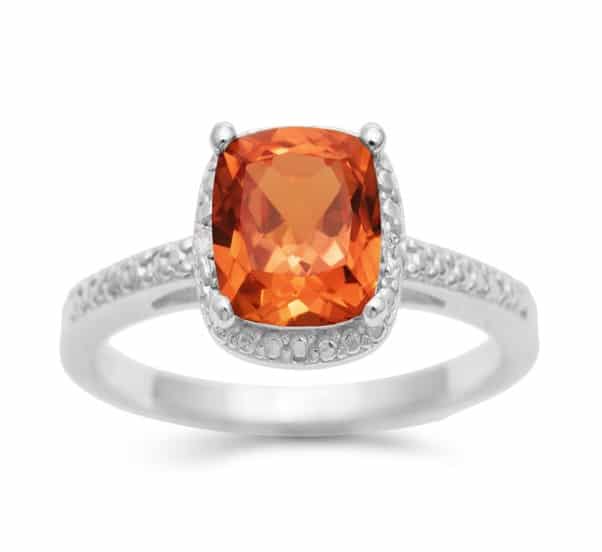
Sapphires are known for their exemplary blue color. But there is actually a rainbow of hues available for this gemstone. The padparadscha sapphire is a rare but striking version of this gem that is pink- and orange-toned, offering a colorful alternative to the more well-known blue. September birthdays may especially enjoy the variety of choosing a padparadscha sapphire, as sapphire is the birthstone for September.
Part of the long history of sapphires, which traced the gem’s popularity to the Middle Ages, padparadscha sapphires are especially well known for their associations with creativity, energy, and good health. The word “padparadscha” is derived from the Sinhalese word for “lotus flower,” owing to that blossom’s brightly colored pink petals, which are echoed in the bright pink-orange of this gemstone.
Padparadscha sapphires are typically found in Sri Lanka (formerly Ceylon), where the Sinhalese people have lived for centuries, but the gemstones have also been uncovered in Tanzania and Madagascar. This stone is durable, too, rating a 9 on the Mohs Hardness Scale—just beneath a diamond.
An exceedingly rare gem, padparadscha sapphires hit the celebrity spotlight recently when Princess Eugenie of England revealed her engagement ring to be a padparadscha sapphire surrounded by diamonds. She carries on the royal association with sapphires—Princess Diana famously receiving a blue sapphire engagement ring from Prince Charles, as well as a suite of sapphire jewelry as a wedding gift in 1981, and Princess Kate later wearing the gemstones in jewelry of her own.
How is a padparadscha sapphire different?
So, what is the difference between a padparadscha sapphire and the more well-known blue variety?
Of course, first and most obvious is the color disparity, the salmon-colored padparadscha sapphire being a strikingly different hue. But it’s the chemical makeup of these gems that alter their coloring, making them different. Typical blue sapphires get their color from the addition of titanium and iron to the mineral corundum, whereas padparadscha sapphires are corundum with trace elements of chromium and iron added. Chromium is also the element that gives rubies their red hue, so it stands to reason that a dash of chromium would tinge corundum with that color as well.
Another difference between padparadscha sapphires and blue sapphires is their relative scarcity. While both gemstones are precious, padparadscha sapphires are quite rare (which also affects their cost per carat).
How to buy a padparadscha sapphire?
Have you fallen in love with padparadscha sapphires yet? Once you’ve seen this beautiful gemstone, it’s only natural to want one for yourself! Buying one of these precious gems will require some expert guidance, though, as it can be easy to confuse a natural padparadscha sapphire with a lab-created one. The untrained eye might even confuse a different type of gemstone for this rare gem entirely. It’s important to critically evaluate your potential padparadscha purchase for quality, including the clarity, cut, and color. Expert assistance can help.
Consult an AGS Jeweler
To buy a sapphire with confidence, consult an American Gem Society (AGS) jeweler. AGS-certified jewelers are committed to upholding the strictest gemological and ethical standards, and they are devoted to customer education and satisfaction.
Jewelers with an AGS credential are experts in precious metals and gemstones, and they’ll be able to help you identify genuine padparadscha sapphires. They are also knowledgeable about the enhancements that are often performed on these sapphires, which may include heat treating to enhance the coloration.
Heat-treated sapphires will maintain the same coloration for years to come, and this treatment may improve their clarity, too. But you deserve to know whether your stone has been treated or not, and an AGS jeweler can help.
There are other treatments which may have been applied to a gem you are considering, too, such as irradiation. This may give a gem a “padparadscha” color, but those tones may fade over time with exposure to sunlight. A stone may have been “surface diffused” to affect its color, dyed, oiled, or treated in another way. There are also synthetic sapphires that cost much less to produce.
With the help of a reputable jeweler, you can make your jewelry purchase confidently and with the best information available, so you too can enjoy the unique fire and sparkle of this “lotus blossom” gemstone for years to come.